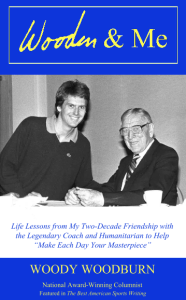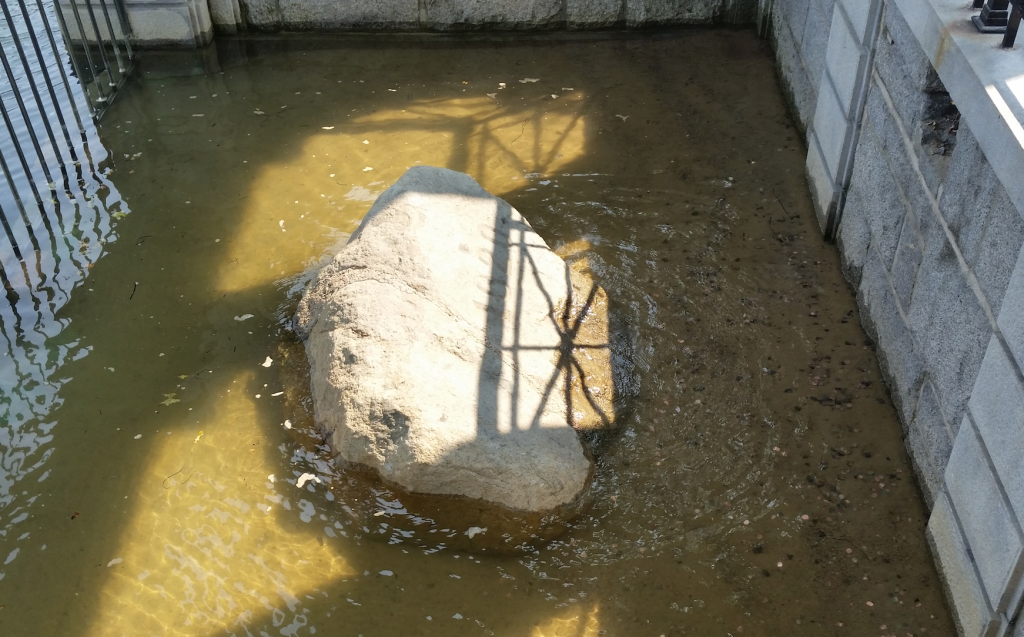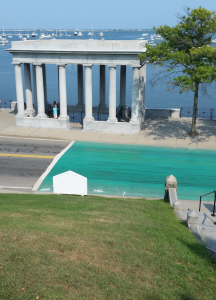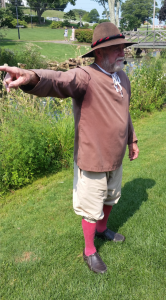Woody’s new book STRAWBERRIES IN WINTERTIME: Essays on Life, Love, and Laughter is available for Pre-Order HERE NOW!
Essays on Life, Love, and Laughter is available for Pre-Order HERE NOW!
* * *
Visiting America’s Rock of Ages
This is the first in a four-column series on my recent travels to the Eastern Seaboard to visit my son – and visit much more.
* * *
Printed in red letters on a white background, the poster-sized wooden sign reads: “Welcome To The 17th Century.”
Meanwhile, 20 yards from where I stood at “Plimouth Plantation” – Plymouth purposely spelled phonetically the way Governor William Bradford did in the 1600s – stood a red vending machine with familiar white script: Coca-Cola.
It was a microcosm of my visit to Plymouth, Mass: While trying to step back nearly 400 years in American history, one foot always seemed to remain firmly planted in the 21st Century.
For instance, the Mayflower II, a replica of the famous ship the Pilgrims sailed on to America in 1620, is docked beside motorboats with sleek modern sailboats cruising in the backdrop.
Still, if you narrow your aperture on the full-scale reproduction (about 100 feet long and 25 feet wide), you realize the Mayflower was extremely small to carry 102 passengers in the cargo hold – plus 30 crewmen on deck. Indeed, what a cramped, claustrophobic, courageous journey their 66 days at sea must have been.
With a dose of imagination, the Mayflower comes into focus like a wooden Apollo 11 with two tall masts. Stepping onto Plymouth Rock, as legend claims the Pilgrim party did, was arguably a bigger leap for mankind than Neil Armstrong’s first lunar footprint 349 years later. After all, those 102 Pilgrims have an estimated 32 million descendants today while the population on the moon remains zero.
Consider just one passenger, John Howland. It is remarkable the ripples this single settler had on American history. In fact, world events actually hung on the single strand of rope Howland miraculously managed to grab hold of after falling overboard during a storm midway through the voyage.
Because Howland was rescued from the frigid Atlantic waters, he completed the journey; was one of 51 Pilgrims to survive the first winter of illness and hunger; and ultimately had more descendants than any of his fellow passengers.
Moreover, his descendants include U.S. presidents Franklin D. Roosevelt and both George Bushes. Also, literature’s Henry Wadsworth Longfellow and Ralph Waldo Emerson. None of these important figures would have been born had Howland perished before grabbing that fateful towline.
Leo Martin, a renowned historian, was our guide for a foot tour of all things Pilgrim. He dressed the part, wearing a brown felt hat and matching shirt with laces at the neck, tan knickers, red stockings and – Coca-Cola-like juxtaposition – modern walking shoes.
The two-hour field trip was far more fascinating than the classroom lectures of my youth. One nugget: Leo noted that Bradford brought 400 books on the Mayflower – more volumes than Harvard had when it was founded.
While the Pilgrim colony library was large, Plymouth Rock is not. Indeed, it underwhelms many largely because it is so small. Originally 15 feet long, three feet wide, and weighing 10 tons, what remains visible on shore today is only about the size of a queen mattress.
No matter. “The Great Rock” gave me goose bumps.
Plymouth Rock rests inside a steel cage, like a zoo animal almost, to protect it from thieves who would chip off souvenir chunks. Five feet above, at street level, the sacred site is surrounded by a beautiful open-air outdoor columned structure resembling a Roman temple.
A piece of Plymouth Rock is on display a few blocks away in Pilgrim Hall, America’s oldest continuously operating museum. Rubbing the stone is said to bring good luck, much like kissing Ireland’s Blarney Stone promises the gift of eloquence. I remain hopeful still of receiving both rewards.
Too, I have rubbed a tiny slice of moon rock in the Smithsonian’s National Air and Space Museum and, honestly, touching America’s Rock of Ages was an equal thrill. After all, if the story of Plymouth Rock is true and not apocryphal, then this modest boulder is ground zero for 21st Century America.
“I believe the Pilgrims did step on Plymouth Rock,” Leo told me, and I choose to believe him. As Hemingway wrote in The Sun Also Rises: “Isn’t it pretty to think so?”
* * *
Woody Woodburn writes a weekly column for The Ventura County Star and can be contacted at WoodyWriter@gmail.com.
 Check out my new memoir WOODEN & ME: Life Lessons from My Two-Decade Friendship with the Legendary Coach and Humanitarian to Help “Make Each Day Your Masterpiece”
Check out my new memoir WOODEN & ME: Life Lessons from My Two-Decade Friendship with the Legendary Coach and Humanitarian to Help “Make Each Day Your Masterpiece”
- Personalized signed copies are available at WoodyWoodburn.com
- Unsigned paperbacks or Kindle ebook can be purchased here at Amazon



